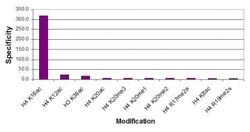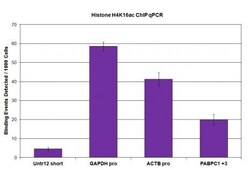Antibody data
- Antibody Data
- Antigen structure
- References [0]
- Comments [0]
- Validations
- Western blot [1]
- ELISA [1]
- Chromatin Immunoprecipitation [3]
- Other assay [1]
Submit
Validation data
Reference
Comment
Report error
- Product number
- 39068 - Provider product page

- Provider
- Invitrogen Antibodies
- Product name
- Histone H4K16ac Polyclonal Antibody
- Antibody type
- Polyclonal
- Antigen
- Synthetic peptide
- Reactivity
- Human, Mouse, Drosophila, Yeast
- Host
- Rabbit
- Isotype
- IgG
- Vial size
- 50 µL
- Concentration
- Conc. Not Determined
- Storage
- -20° C, Avoid Freeze/Thaw Cycles
No comments: Submit comment
Supportive validation
- Submitted by
- Invitrogen Antibodies (provider)
- Main image

- Experimental details
- Histone H4K16ac antibody (pAb) tested by Western blot. HeLa nuclear extract (20 µg) probed with Histone H4 acetyl Lys16 polyclonal antibody (1:1,000 dilution). Lane 1: No treatment. Lane 2: Cells treated with sodium butyrate.
Supportive validation
- Submitted by
- Invitrogen Antibodies (provider)
- Main image

- Experimental details
- Histone H4K16ac antibody (pAb) specificity tested by peptide array analysis. Peptide array analysis was used to confirm the specificity of this antibody for its intended modification. Histone H4 acetyl Lys16 antibody was applied at a dilution of 1:10,000 to Active Motifs MODified™ Histone Peptide Array (Catalog No. 13001). The arrays were scanned with ArrayAnalysis Software 7 and the results plotted. Specificity data is shown for the most reactive peptides and those related to the immunogen. In the array, the acetyl Lys16 modification is found on peptides with two different backbone sequences (H4 amino acids 1-19 and amino acids 11-30) so reactive and related peptides for both peptides is shown. Array Data File
Supportive validation
- Submitted by
- Invitrogen Antibodies (provider)
- Main image

- Experimental details
- Histone H4K16ac antibody (pAb) tested by ChIP-Seq. ChIP was performed using the ChIP-IT® High Sensitivity Kit (Cat. No. 53040) with 15 ug of chromatin from HeLa cells and 10 µl of antibody. ChIP DNA was sequenced on the Illumina HiSeq and 12 million sequence tags were mapped to identify Histone H4K16ac binding sites. The image shows binding across a region of chromosome 5. You can view the complete data set in the UCSC Genome Browser, starting at this specific location, here.
- Submitted by
- Invitrogen Antibodies (provider)
- Main image

- Experimental details
- Histone H4K16ac antibody (pAb) tested by ChIP. Chromatin immunoprecipitation (ChIP) was performed using the ChIP-IT® High Sensitivity Kit (Cat. No. 53040) with 5 µg of chromatin from HeLa cells and 10 µl of Histone H4K16ac antibody. ChIP DNA was used in qPCR with the negative control primer pairs or gene-specific primer pairs as indicated. Data are presented as Binding Events Detected per 1000 Cells using Active Motifs Epigenetic Services normalization scheme which accounts for primer efficiency and the amount of chromatin used in the ChIP reaction.
- Submitted by
- Invitrogen Antibodies (provider)
- Main image

- Experimental details
- Histone H4K16ac antibody (pAb) tested by ChIP-Seq. ChIP was performed using the ChIP-IT® High Sensitivity Kit (Cat. No. 53040) with 15 ug of chromatin from HeLa cells and 10 µl of antibody. ChIP DNA was sequenced on the Illumina HiSeq and 12 million sequence tags were mapped to identify Histone H4K16ac binding sites. The image shows binding across a region of chromosome 5. You can view the complete data set in the UCSC Genome Browser, starting at this specific location, here.
Supportive validation
- Submitted by
- Invitrogen Antibodies (provider)
- Main image

- Experimental details
- Histone H4K16ac antibody (pAb) tested by dot blot analysis. Dot blot analysis was used to confirm the specificity of Histone H4 acetyl Lys16 pAb for histone H4 acetyl Lys16. Acetylated peptides corresponding to the immunogen and related H4 sequences were spotted onto PVDF and probed with the antibody at 1:1,000. The amount of peptide (picomoles) spotted is indicated next to each row. Lane 1: Unmodified Lys8 peptide. Lane 2: Acetyl Lys5 peptide. Lane 3: Acetyl Lys8 peptide. Lane 4: Acetyl Lys12 peptide. Lane 5: Unmodified Lys16 peptide. Lane 6: Acetyl Lys16 peptide. Lane 7: Acetyl Lys20 peptide. Lane 8: Unmodified Lys31 peptide. Lane 9: Acetyl Lys31 peptide. Lane 10: Acetyl Lys59 peptide. Lane 11: Acetyl Lys91 peptide.
 Explore
Explore Validate
Validate Learn
Learn Western blot
Western blot